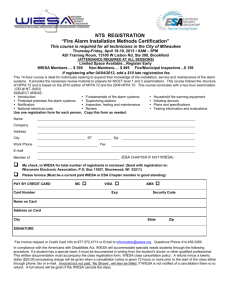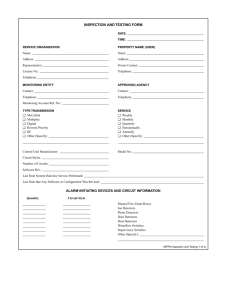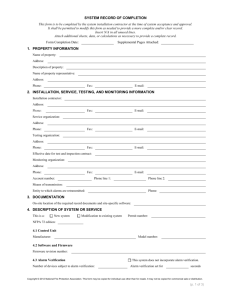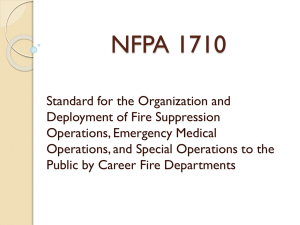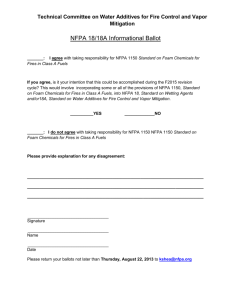Inspection and Testing of Fire Alarm Systems
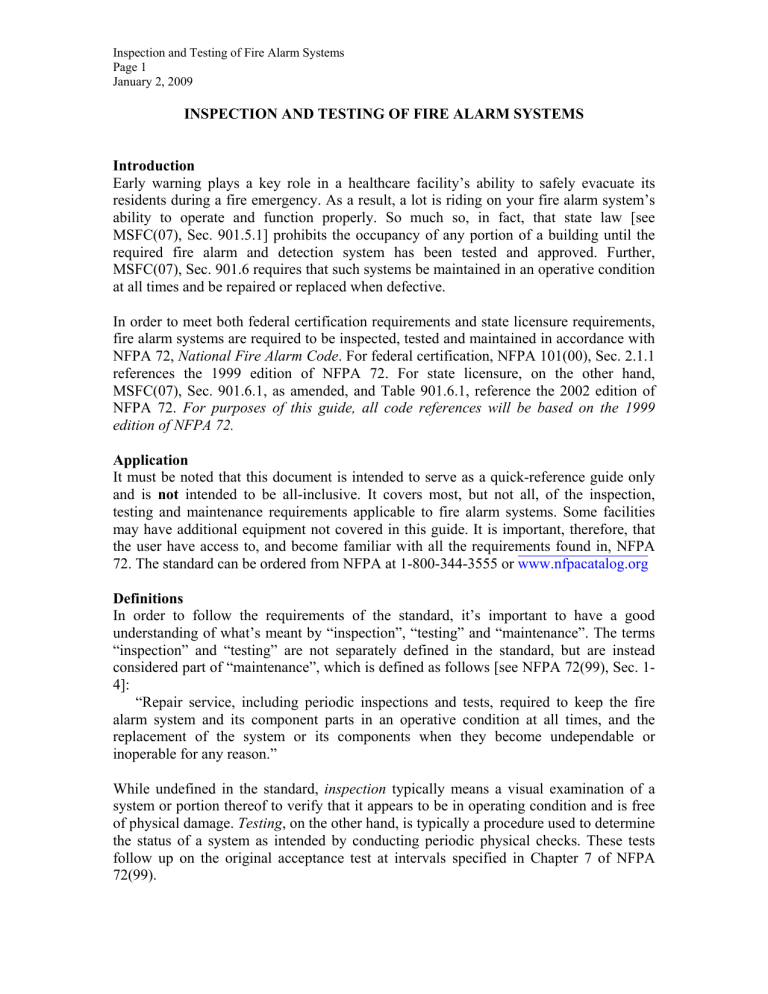
Inspection and Testing of Fire Alarm Systems
Page 1
January 2, 2009
INSPECTION AND TESTING OF FIRE ALARM SYSTEMS
Introduction
Early warning plays a key role in a healthcare facility’s ability to safely evacuate its residents during a fire emergency. As a result, a lot is riding on your fire alarm system’s ability to operate and function properly. So much so, in fact, that state law [see
MSFC(07), Sec. 901.5.1] prohibits the occupancy of any portion of a building until the required fire alarm and detection system has been tested and approved. Further,
MSFC(07), Sec. 901.6 requires that such systems be maintained in an operative condition at all times and be repaired or replaced when defective.
In order to meet both federal certification requirements and state licensure requirements, fire alarm systems are required to be inspected, tested and maintained in accordance with
NFPA 72, National Fire Alarm Code . For federal certification, NFPA 101(00), Sec. 2.1.1 references the 1999 edition of NFPA 72. For state licensure, on the other hand,
MSFC(07), Sec. 901.6.1, as amended, and Table 901.6.1, reference the 2002 edition of
NFPA 72. For purposes of this guide, all code references will be based on the 1999 edition of NFPA 72.
Application
It must be noted that this document is intended to serve as a quick-reference guide only and is not intended to be all-inclusive. It covers most, but not all, of the inspection, testing and maintenance requirements applicable to fire alarm systems. Some facilities may have additional equipment not covered in this guide. It is important, therefore, that the user have access to, and become familiar with all the requirements found in, NFPA
72.
The standard can be ordered from NFPA at 1-800-344-3555 or www.nfpacatalog.org
Definitions
In order to follow the requirements of the standard, it’s important to have a good understanding of what’s meant by “inspection”, “testing” and “maintenance”. The terms
“inspection” and “testing” are not separately defined in the standard, but are instead considered part of “maintenance”, which is defined as follows [see NFPA 72(99), Sec. 1-
4]:
“Repair service, including periodic inspections and tests, required to keep the fire alarm system and its component parts in an operative condition at all times, and the replacement of the system or its components when they become undependable or inoperable for any reason.”
While undefined in the standard, inspection typically means a visual examination of a system or portion thereof to verify that it appears to be in operating condition and is free of physical damage. Testing , on the other hand, is typically a procedure used to determine the status of a system as intended by conducting periodic physical checks. These tests follow up on the original acceptance test at intervals specified in Chapter 7 of NFPA
72(99).
Inspection and Testing of Fire Alarm Systems
Page 2
Personnel qualifications
It is the facility’s responsibility to ensure that only properly trained and competent persons perform inspections, testing and maintenance on its fire alarm system [see NFPA
72(99), Sec. 7-1.2]. Typically, facility personnel are limited to performing inspection and some basic testing activities only. The amount of testing that can be performed will depend on the level of training received. One of the best sources for such training would be the fire alarm contractor that performs the facility’s annual service. Evidence of any training received will need to be maintained in each employee’s personnel file.
System history
NFPA 72(99), Sec. 7-5.2.2 requires that a permanent record be kept of all inspections, testing and maintenance performed on a fire alarm system. A number of requirements applied to a healthcare facility’s fire protection systems are based on the age and date of installation of those systems. Without an accurate written history of the fire protection system(s) in your facility, it can be difficult to prove to a state or federal life safety surveyor that those systems are being maintained in accordance with applicable state and federal standards. This can result in fire/life safety deficiencies being cited. Turnover of administrative and/or maintenance personnel only serves to compound the problem. One of the best ways to deal with this is to create and maintain an historical record on your system(s).
As with just about anything, the hardest part of creating an historical record is getting started – after that, it’s a matter of keeping it up-to-date. You should find the fire alarm contractor that provides your annual service to be an excellent source of information about your system. Basic questions that need to be answered include:
When was the system initially installed? Who installed it?
Were any additions, modifications or repairs made to the system? When? Who did the work?
What means of communication is used to transmit a fire alarm signal between your facility and the supervising station?
What type of batteries, if any, serve as a secondary power supply for the fire alarm system?
It’s important to note that certain changes made to your building could necessitate modifications to your fire alarm system. Things to watch for include construction or removal of walls, change in use of an area, and installation or removal of fire sprinkler protection.
A sample historical record has been developed for your use. The record can be used “as is” or serve as a guide that you can use to create your own record. A completed record is provided to serve as an example of how the record is expected to be filled out.
Click Here for Sample Historical Record
Inspection and Testing of Fire Alarm Systems
Page 3
Specific Requirements
The inspection, testing and maintenance requirements that apply to your building’s fire alarm system start from the date of initial installation and continue on at specific intervals throughout the life of the system. What follows is a brief synopsis of some of the major requirements you need to be aware of.
Notifications
In order to avoid unnecessary occupant response and potential injury to emergency response personnel, it is very important that all affected parties be notified prior to any scheduled testing of the fire alarm system [see NFPA 72(99), Sec. 7-1.3]. Those notified should include, but not be limited to, building occupants (e.g. visitors, staff and patients/residents) and the monitoring company or agency.
New installations
In order to meet both federal certification requirements and state licensure requirements, fire alarm systems are required to be installed in accordance with NFPA 72 and the requirements of the Minnesota State Fire Code (MSFC) and NFPA 101 applicable to I-2 or healthcare occupancies [see MSFC(07), Sections 907.2 and 907.3; NFPA 101(00),
Sections 18/19.3.4 and 9.6.1.4]. All newly installed systems are required to be acceptance tested in accordance with the requirements of Chapter 7 of NFPA 72(99). MSFC(07),
Sec. 901.5 requires that the fire code official be notified prior to such testing.
System modifications
1. Reacceptance testing is required after any of the following occur [see NFPA 72(99),
Sec. 7-1.6.2]:
•
Addition or deletion of system components
•
Any modification, repair or adjustment to system hardware or wiring
•
Any change to site-specific software
2. Again, MSFC(07), Sec. 901.5 requires that the fire code official be notified prior to such testing.
3. The extent of testing necessary is determined as follows:
•
All components, circuits, system operations or site-specific software functions known to be affected by changes or modifications made to the system must be
100 percent tested.
•
Ten (10) percent of initiating devices that are not directly affected, up to a maximum of 50 devices, must also be tested and proper operation verified.
•
Whenever there are changes to control units connected or controlled by the system executive software, a 10 percent functional test of the system is required, including a test of at least one device on each input and output circuit to verify critical system functions such as notification appliances, control functions and off-premises reporting.
Inspection and Testing of Fire Alarm Systems
Page 4
Semiannually
1. Certain fire alarm system components need to be visually inspected semiannually [see
NFPA 72(99), Table 7-3.1]. These visual inspections can be performed by facility staff and include: a. Control unit trouble signals – verify that they are readily visible b. Remote annunciators – verify that they are in proper operating condition and free of damage c. Initiating devices – verify that they are in place, unobstructed and free of damage
– to include:
•
Manual fire alarm boxes
•
Heat detectors d. Notification appliances – verify that they are unobstructed and free of damage e. Magnetic hold-open devices – verify that they are free of damage and function properly
2. A visual inspection of fire alarm interconnect switches on kitchen hood extinguishing systems is also required.
3. By exception, where a listed addressable fire alarm system is present that performs at least weekly automatic inspections of system components, the visual inspections are allowed to be conducted annually. The system would need to be capable of producing a print-out documenting these weekly inspections.
4. Inspection and testing of batteries, smoke detectors (both hard-wired and batteryoperated) and equipment used to transmit signals to a supervising station are covered later on in this guide.
Annually
1. The entire system is required to be thoroughly inspected, tested and maintained each year by an approved servicing company in accordance with Chapter 7 of NFPA
72(99) [see NFPA 72(99), Tables 7-2.2, 7-3.1 and 7-3.2; NFPA 90A(99), Sec. 4-4.1].
Testing must include control equipment, remote annunciators, initiating devices,
HVAC shutdown devices and alarm notification appliances.
2. Fire alarm interconnect switches on kitchen hood extinguishing systems are also required to be tested annually.
3. Inspection, testing and maintenance of batteries, smoke detectors (both systemconnected and battery-operated) and equipment used to transmit signals to a supervising station are covered later on in this guide.
Long term
1. Nonrestorable fixed-temperature, spot-type heat detectors are required to be replaced after 15 years from initial installation [see NFPA 72(99), Table 7-2.2, Item 13.d.3].
As an alternate, 2 detectors per 100 must be laboratory tested. If these detectors fail when tested, additional detectors must be tested to determine if the problem is a general or localized one.
•
If detectors are tested instead of replaced, tests must be repeated at 5-year intervals.
2. For rate-of-rise heat detectors and restorable fixed-temperature, spot-type heat detectors, 2 or more detectors must be tested on each initiating circuit annually [see
Inspection and Testing of Fire Alarm Systems
Page 5
NFPA 72(99), Sec. 7-3.2.3]. Different detectors must be tested each year, with records kept specifying which detectors were tested. Within 5 years, each detector must have been tested.
Batteries
1. Batteries serving as a secondary power supply for fire alarm systems must be visually inspected at the following intervals to verify that they are free of damage* [see NFPA
72(99), Table 7-3.1, Item 3]: a. Lead-acid and primary (Dry Cell) batteries – monthly b. Nickel-Cadmium and sealed lead-acid batteries – semiannually
(*You’ll also want to: check electrolyte (fluid) levels and tightness of connections; check for corrosion or leakage; and, if necessary, clean the terminals.)
2. Batteries serving as a secondary power supply for fire alarm systems must be tested semiannually, to include [see NFPA 72(99), Table 7-3.2, Item 6]: a. Load voltage tests on lead-acid, Nickel-Cadmium and sealed lead-acid type batteries
•
Monthly load voltage tests are required on primary (Dry Cell) batteries b. 30-minute discharge tests on lead-acid type batteries c. Testing of specific gravity on lead-acid type batteries
3. An annual charger test, conducted in accordance with NFPA 72(99), Table 7-2.2,
Item 6, is required for lead-acid, Nickel-Cadmium and sealed lead-acid type batteries
(this involves the use of a voltmeter or ampere meter) [see NFPA 72(99), Table 7-3.2,
Item 6].
•
Batteries must be replaced as needed, but typically last 3 years or more. Sealed lead-acid type batteries, however, are required to be replaced every 4 years.
Smoke detectors
1. Battery-operated
Some facilities have had battery-operated smoke detectors installed to meet the federal certification requirements of NFPA 101(00), Sections 18/19.7.5.2 and
18/19.7.5.3 and/or 42 CFR Part 483.70(a)(7)(ii) – requirements that apply to buildings that are either unsprinklered or only partially sprinklered. a. These detectors must be tested and maintained in accordance with manufacturer’s instructions. This means that:
•
Detectors must be tested on a weekly or monthly basis as specified.
•
Detectors must be cleaned monthly in accordance with manufacturer’s instructions [NOTE: Some manufacturers may recommend less frequent cleaning intervals].
•
Batteries must be replaced annually or semiannually as specified by the manufacturer. b. Based on regulations published in the August 13, 2008 Federal Register , batteryoperated smoke detectors will no longer be required in long-term care facilities effective August 13, 2013, as all such facilities will then be required to be protected throughout by an approved, supervised automatic fire sprinkler system by that date [see 42 CFR Part 483.70(a)(8)].
Inspection and Testing of Fire Alarm Systems
Page 6 a. Hard-wired (including low voltage) automatic smoke detectors, including duct smoke detectors, must be visually inspected semiannually [see NFPA 72(99), Sec.
7-3.1 and Table 7-3.1].
Exception : For listed addressable fire alarm systems that perform automatic inspections at a frequency of not less than weekly, the visual inspections are allowed to be conducted annually. The system would need to be capable of producing a print-out documenting these weekly inspections. b. Hard-wired (including low voltage) smoke detectors must be sensitivity tested in accordance with NFPA 72(99), Sec. 7-3.2.1.
•
This section requires that detector sensitivity be checked within 1 year after installation and every other year thereafter.
•
Detectors found to have a sensitivity outside the listed and marked sensitivity range must be cleaned and recalibrated or be replaced.
•
If, after the second test, detectors are found to have remained within their listed and marked sensitivity range (or 4 percent obscuration light gray smoke, if not marked), the length of time between sensitivity tests may be extended to a maximum of 5 years. c. Something to keep in mind about detector testing: Smoke entry tests are required for functional and sensitivity testing of smoke detectors. Magnet tests do not replace smoke entry tests.
Alarm transmission equipment
An introduction
NFPA 101(00), Sec. 18/19.3.4.3.2 requires automatic fire department notification on activation of the building fire alarm system. This is typically accomplished by contracting with a company or agency that provides what’s called a central supervising station service. On receipt of a fire alarm signal from your facility, operators at the supervising station turn around and retransmit the signal to the local 9-1-1 communications center. In some locations, the local 9-1-1 communications center will accept fire alarm signals directly (this is called remote supervising station service).
The means of communication between your facility and the supervising station is required to be inspected and tested to ensure its reliability. The kind of testing required is based on the method of communication employed. NFPA 72 allows the use of a number of transmission technologies [see NFPA 72(99), Sec. 5-5.2.1.1] to include:
•
Multiplex signaling systems
•
Digital alarm communicator systems, including digital alarm radio systems
•
McCulloh systems
•
Two-way radio frequency (RF) multiplex systems
•
One-way radio alarm systems
•
Directly-connected noncoded systems
The method of communication most commonly employed at healthcare facilities is the
Digital Alarm Communicator Transmitter (DACT) – also called an automatic dialer. For
Inspection and Testing of Fire Alarm Systems
Page 7 that reason, this guide will not address the other transmission technologies except to say that:
•
Information about them can be found in NFPA 72(99), Sec. 5-5, and
•
Inspection and test intervals for other transmission technologies are outlined in
NFPA 72(99), Tables 7-3.1 and 7-3.2. It’s important to note that where technologies not specifically listed in Table 7-3.2 are employed, the transmission equipment must be tested quarterly as specified in NFPA 72(99), Table 7-3.2,
Item 20 for Off-Premises Transmission Equipment .
The DACT is a component at the facility that, upon receipt of a signal from the fire alarm control panel, seizes a connected telephone line, dials one of two pre-selected numbers to connect to the supervising station and transmits the necessary alarm, trouble or supervisory signal. One of the easiest ways to tell if you have a DACT is to check the communicator to see how many outgoing connections it has – a DACT requires two paths for transmitting fire alarm signal information.
CAUTION: NFPA 72(99), Sec. 5-5.3.2.1.1 only allows a DACT to be connected to a
“loop start telephone circuit”. Such circuits employ copper lines that allow the local phone company to provide back-up power in case of a failure of the public utility power. The use of fiber-optic cable is, however, becoming more and more common.
A DACT cannot use fiber-optic cable and be code-compliant – in other words, if your facility’s phone system employs fiber-optic cable only, a different transmission technology will need to be used to communicate with the supervising station .
Depending upon the technology chosen, quarterly testing of the transmission equipment may be required [see NFPA 72(99), Table 7-3.2].
Inspection and testing
DACTs are required to be visually inspected semiannually to verify that they are free of obvious damage and tested annually [see NFPA 72(99), Tables 7-3.1 and 7-3.2]. DACT testing requirements are detailed in NFPA 72(99), Table 7-2.2, Item 16 and include:
•
Testing for line seizure capability
•
Disconnect of the primary line from the DACT to confirm a trouble signal on-site and transmission of a trouble signal to the central station within 4 minutes
•
Disconnect of the secondary line (as above)
•
Simulation of a fault in the primary telephone number
Documentation Requirements
Almost as important as conducting required inspections, testing and maintenance is documenting the fact that they occurred. NFPA 72 requires that these services be properly recorded. What follows is a brief synopsis of some of the major documentation requirements you need to be aware of.
Initial installation records
As mentioned earlier, MSFC(07), Sec. 901.5.1 makes it unlawful to occupy any portion of a building until the required fire alarm and detection system has been tested and
Inspection and Testing of Fire Alarm Systems
Page 8 approved. Before approving and accepting a fire alarm system, the AHJ will want written proof that operational acceptance tests have been completed. Proper documentation in the form of a Record of Completion serves as evidence that this has occurred. A sample
Record of Completion form can be found in NFPA 72(99) – see Figure 1-6.2.1
.
NFPA 72(99), Sec. 1-6.2.1.1 requires that all fire alarm systems modified after the initial installation have the original record of completion revised to show all changes from the original information, including revision dates.
The installing contractor is required, at a minimum, to provide you with the following
[see NFPA 72(99), Sec. 1-6.2; MSFC(07), Sec. 901.6.2.1]:
1. Name of installation contractor
2. Record of completion
3. Owner’s manual and installation instructions covering all system equipment. This should include: recommended, including:
•
Listing of the individual system components that require periodic testing and maintenance
•
Step-by-step instructions detailing the requisite testing and maintenance procedures, and the intervals at which these procedures need to be performed, for each type of device installed
•
A testing and maintenance schedule e. A service directory that includes a list of the names and telephone numbers of those who provide service for the system
Semiannual/annual records
A sample semiannual inspection and battery inspection/test log has been developed to serve as a guide that you can use in creating your own log. A completed log is provided to serve as an example of how the log is expected to be filled out.
Click Here for Sample Inspection/Test Log
A sample annual inspection and testing form can be found in NFPA 72 [see NFPA
72(99), Figure 7-5.2.2 or NFPA 72(02), Figure 10.6.2.3]. This form is also available on the Minnesota Health Care Engineers Association’s web site ( www.mhcea.org
). While some fire alarm companies simply photocopy this sample for use in documenting their annual visits, many others will create their own forms. That’s okay as far as NFPA 72 is concerned, so long as all the applicable information requested in Figure 7-5.2.2/10.6.2.3 is included in their form.
Inspection and Testing of Fire Alarm Systems
Page 9
A word of caution would be in order here, however.
Experience from Federal Monitoring
Surveys performed by the Centers for Medicare and Medicaid Services (CMS) has shown that CMS surveyors are insisting on the use of either the NFPA 72 form or a form that includes ALL of the same information. Failure to use the NFPA 72 (or similar) form and fill it in completely (including marking non-applicable portions “N/A” in some fashion) will likely result in the issuance of a fire alarm testing/maintenance (K052) deficiency. It is strongly recommended, therefore, that facilities consider insisting that their fire alarm contractors use the NFPA 72 form to document annual inspection and testing.
Smoke detector sensitivity testing
Sensitivity tests must be properly documented to include detector location, the listed sensitivity range of the detector, tested sensitivity range, pass/fail, date of test, and name of person performing the testing. A sample smoke detector sensitivity testing log has been developed to serve as a guide that you can use in creating your own log. A completed log is provided to serve as an example of how the log is expected to be filled out.
Click Here for Sample Sensitivity Test Log
Battery-operated smoke detectors – testing/maintenance
Documentation must be provided to show that battery-operated smoke detectors are being tested and maintained in accordance with the manufacturer’s instructions. This documentation should include:
•
A copy of the manufacturer’s instructions that accompanied the detectors at time of purchase, and
•
A log showing the tests and maintenance performed in accordance with those instructions. A sample battery-operated smoke detector testing/maintenance log has been developed to serve as a guide that you can use in creating your own log.
A completed log is provided to serve as an example of how the log is expected to be filled out.
Click Here for Sample Battery-Operated Smoke Detector Lo g
It’s important that at least two people in your facility know where your records are kept to help ensure that they can be readily provided when requested during an inspection.
MSFC(07), Sec. 901.6.2 requires that these records be maintained on the premises for at least three years (longer if smoke detector sensitivity testing is extended out to 5-year intervals) and must be copied for the fire code official upon request.
